Factors Affecting a Child's Education and Future Success
VerifiedAdded on 2023/01/23
|6
|1770
|94
AI Summary
This article explores the various factors that contribute to a child's education and future success. It discusses the influence of parents' education and family income on academic achievement. The study also includes a methodology section and analysis of the data collected.
Contribute Materials
Your contribution can guide someone’s learning journey. Share your
documents today.

Statistics
Statistics
Student name:
Tutor name:
1 | P a g e
Statistics
Student name:
Tutor name:
1 | P a g e
Secure Best Marks with AI Grader
Need help grading? Try our AI Grader for instant feedback on your assignments.
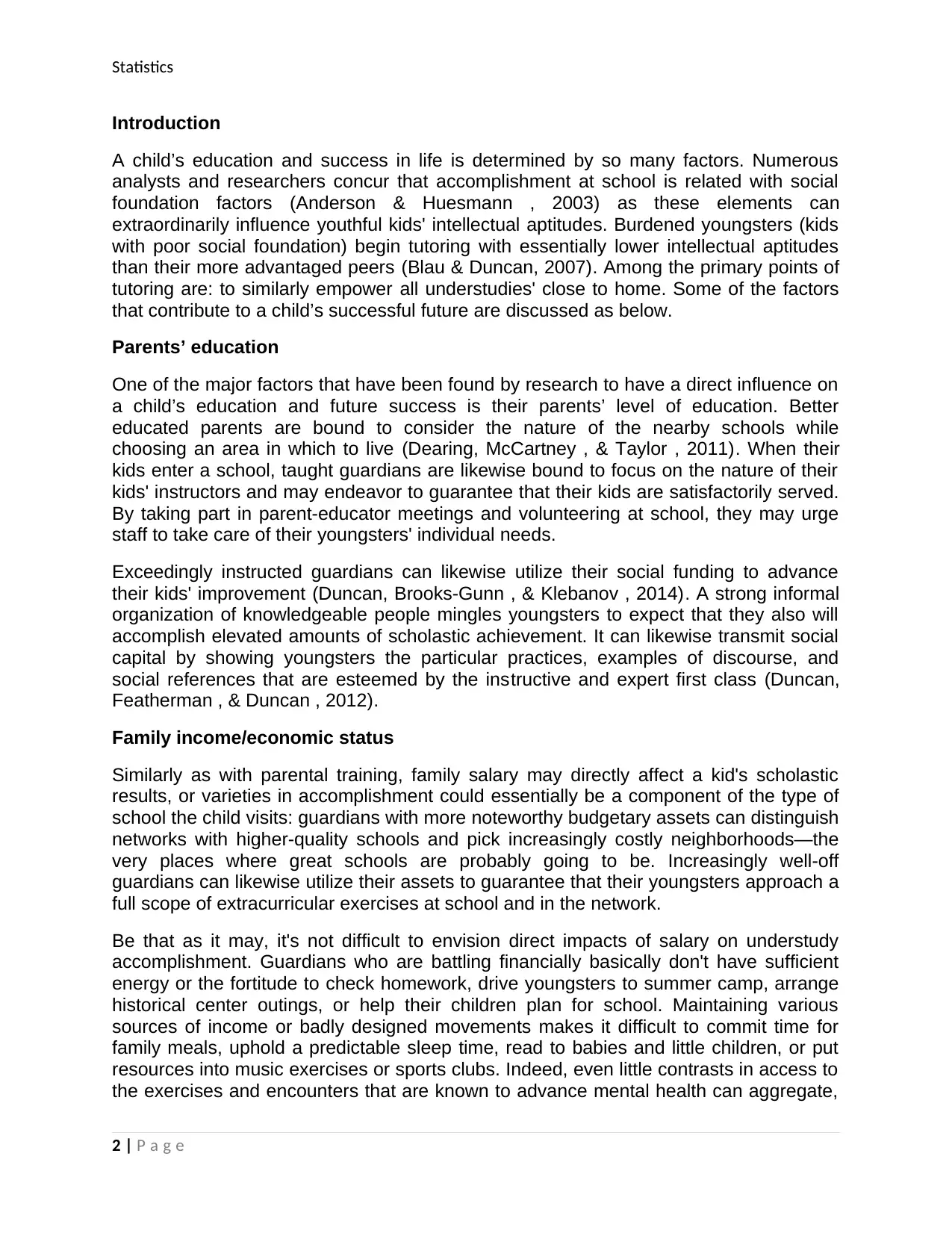
Statistics
Introduction
A child’s education and success in life is determined by so many factors. Numerous
analysts and researchers concur that accomplishment at school is related with social
foundation factors (Anderson & Huesmann , 2003) as these elements can
extraordinarily influence youthful kids' intellectual aptitudes. Burdened youngsters (kids
with poor social foundation) begin tutoring with essentially lower intellectual aptitudes
than their more advantaged peers (Blau & Duncan, 2007). Among the primary points of
tutoring are: to similarly empower all understudies' close to home. Some of the factors
that contribute to a child’s successful future are discussed as below.
Parents’ education
One of the major factors that have been found by research to have a direct influence on
a child’s education and future success is their parents’ level of education. Better
educated parents are bound to consider the nature of the nearby schools while
choosing an area in which to live (Dearing, McCartney , & Taylor , 2011). When their
kids enter a school, taught guardians are likewise bound to focus on the nature of their
kids' instructors and may endeavor to guarantee that their kids are satisfactorily served.
By taking part in parent-educator meetings and volunteering at school, they may urge
staff to take care of their youngsters' individual needs.
Exceedingly instructed guardians can likewise utilize their social funding to advance
their kids' improvement (Duncan, Brooks-Gunn , & Klebanov , 2014). A strong informal
organization of knowledgeable people mingles youngsters to expect that they also will
accomplish elevated amounts of scholastic achievement. It can likewise transmit social
capital by showing youngsters the particular practices, examples of discourse, and
social references that are esteemed by the instructive and expert first class (Duncan,
Featherman , & Duncan , 2012).
Family income/economic status
Similarly as with parental training, family salary may directly affect a kid's scholastic
results, or varieties in accomplishment could essentially be a component of the type of
school the child visits: guardians with more noteworthy budgetary assets can distinguish
networks with higher-quality schools and pick increasingly costly neighborhoods—the
very places where great schools are probably going to be. Increasingly well-off
guardians can likewise utilize their assets to guarantee that their youngsters approach a
full scope of extracurricular exercises at school and in the network.
Be that as it may, it's not difficult to envision direct impacts of salary on understudy
accomplishment. Guardians who are battling financially basically don't have sufficient
energy or the fortitude to check homework, drive youngsters to summer camp, arrange
historical center outings, or help their children plan for school. Maintaining various
sources of income or badly designed movements makes it difficult to commit time for
family meals, uphold a predictable sleep time, read to babies and little children, or put
resources into music exercises or sports clubs. Indeed, even little contrasts in access to
the exercises and encounters that are known to advance mental health can aggregate,
2 | P a g e
Introduction
A child’s education and success in life is determined by so many factors. Numerous
analysts and researchers concur that accomplishment at school is related with social
foundation factors (Anderson & Huesmann , 2003) as these elements can
extraordinarily influence youthful kids' intellectual aptitudes. Burdened youngsters (kids
with poor social foundation) begin tutoring with essentially lower intellectual aptitudes
than their more advantaged peers (Blau & Duncan, 2007). Among the primary points of
tutoring are: to similarly empower all understudies' close to home. Some of the factors
that contribute to a child’s successful future are discussed as below.
Parents’ education
One of the major factors that have been found by research to have a direct influence on
a child’s education and future success is their parents’ level of education. Better
educated parents are bound to consider the nature of the nearby schools while
choosing an area in which to live (Dearing, McCartney , & Taylor , 2011). When their
kids enter a school, taught guardians are likewise bound to focus on the nature of their
kids' instructors and may endeavor to guarantee that their kids are satisfactorily served.
By taking part in parent-educator meetings and volunteering at school, they may urge
staff to take care of their youngsters' individual needs.
Exceedingly instructed guardians can likewise utilize their social funding to advance
their kids' improvement (Duncan, Brooks-Gunn , & Klebanov , 2014). A strong informal
organization of knowledgeable people mingles youngsters to expect that they also will
accomplish elevated amounts of scholastic achievement. It can likewise transmit social
capital by showing youngsters the particular practices, examples of discourse, and
social references that are esteemed by the instructive and expert first class (Duncan,
Featherman , & Duncan , 2012).
Family income/economic status
Similarly as with parental training, family salary may directly affect a kid's scholastic
results, or varieties in accomplishment could essentially be a component of the type of
school the child visits: guardians with more noteworthy budgetary assets can distinguish
networks with higher-quality schools and pick increasingly costly neighborhoods—the
very places where great schools are probably going to be. Increasingly well-off
guardians can likewise utilize their assets to guarantee that their youngsters approach a
full scope of extracurricular exercises at school and in the network.
Be that as it may, it's not difficult to envision direct impacts of salary on understudy
accomplishment. Guardians who are battling financially basically don't have sufficient
energy or the fortitude to check homework, drive youngsters to summer camp, arrange
historical center outings, or help their children plan for school. Maintaining various
sources of income or badly designed movements makes it difficult to commit time for
family meals, uphold a predictable sleep time, read to babies and little children, or put
resources into music exercises or sports clubs. Indeed, even little contrasts in access to
the exercises and encounters that are known to advance mental health can aggregate,
2 | P a g e
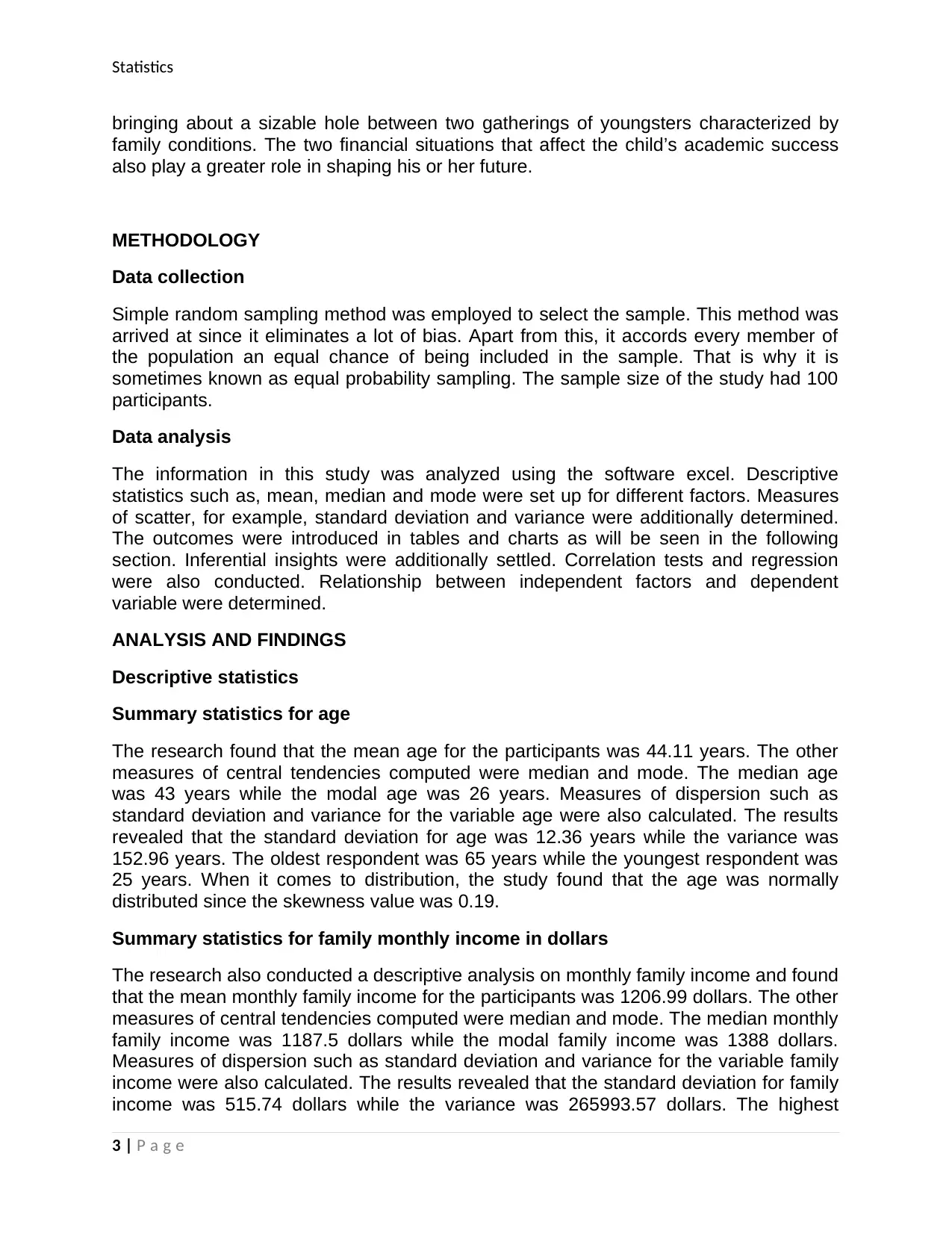
Statistics
bringing about a sizable hole between two gatherings of youngsters characterized by
family conditions. The two financial situations that affect the child’s academic success
also play a greater role in shaping his or her future.
METHODOLOGY
Data collection
Simple random sampling method was employed to select the sample. This method was
arrived at since it eliminates a lot of bias. Apart from this, it accords every member of
the population an equal chance of being included in the sample. That is why it is
sometimes known as equal probability sampling. The sample size of the study had 100
participants.
Data analysis
The information in this study was analyzed using the software excel. Descriptive
statistics such as, mean, median and mode were set up for different factors. Measures
of scatter, for example, standard deviation and variance were additionally determined.
The outcomes were introduced in tables and charts as will be seen in the following
section. Inferential insights were additionally settled. Correlation tests and regression
were also conducted. Relationship between independent factors and dependent
variable were determined.
ANALYSIS AND FINDINGS
Descriptive statistics
Summary statistics for age
The research found that the mean age for the participants was 44.11 years. The other
measures of central tendencies computed were median and mode. The median age
was 43 years while the modal age was 26 years. Measures of dispersion such as
standard deviation and variance for the variable age were also calculated. The results
revealed that the standard deviation for age was 12.36 years while the variance was
152.96 years. The oldest respondent was 65 years while the youngest respondent was
25 years. When it comes to distribution, the study found that the age was normally
distributed since the skewness value was 0.19.
Summary statistics for family monthly income in dollars
The research also conducted a descriptive analysis on monthly family income and found
that the mean monthly family income for the participants was 1206.99 dollars. The other
measures of central tendencies computed were median and mode. The median monthly
family income was 1187.5 dollars while the modal family income was 1388 dollars.
Measures of dispersion such as standard deviation and variance for the variable family
income were also calculated. The results revealed that the standard deviation for family
income was 515.74 dollars while the variance was 265993.57 dollars. The highest
3 | P a g e
bringing about a sizable hole between two gatherings of youngsters characterized by
family conditions. The two financial situations that affect the child’s academic success
also play a greater role in shaping his or her future.
METHODOLOGY
Data collection
Simple random sampling method was employed to select the sample. This method was
arrived at since it eliminates a lot of bias. Apart from this, it accords every member of
the population an equal chance of being included in the sample. That is why it is
sometimes known as equal probability sampling. The sample size of the study had 100
participants.
Data analysis
The information in this study was analyzed using the software excel. Descriptive
statistics such as, mean, median and mode were set up for different factors. Measures
of scatter, for example, standard deviation and variance were additionally determined.
The outcomes were introduced in tables and charts as will be seen in the following
section. Inferential insights were additionally settled. Correlation tests and regression
were also conducted. Relationship between independent factors and dependent
variable were determined.
ANALYSIS AND FINDINGS
Descriptive statistics
Summary statistics for age
The research found that the mean age for the participants was 44.11 years. The other
measures of central tendencies computed were median and mode. The median age
was 43 years while the modal age was 26 years. Measures of dispersion such as
standard deviation and variance for the variable age were also calculated. The results
revealed that the standard deviation for age was 12.36 years while the variance was
152.96 years. The oldest respondent was 65 years while the youngest respondent was
25 years. When it comes to distribution, the study found that the age was normally
distributed since the skewness value was 0.19.
Summary statistics for family monthly income in dollars
The research also conducted a descriptive analysis on monthly family income and found
that the mean monthly family income for the participants was 1206.99 dollars. The other
measures of central tendencies computed were median and mode. The median monthly
family income was 1187.5 dollars while the modal family income was 1388 dollars.
Measures of dispersion such as standard deviation and variance for the variable family
income were also calculated. The results revealed that the standard deviation for family
income was 515.74 dollars while the variance was 265993.57 dollars. The highest
3 | P a g e
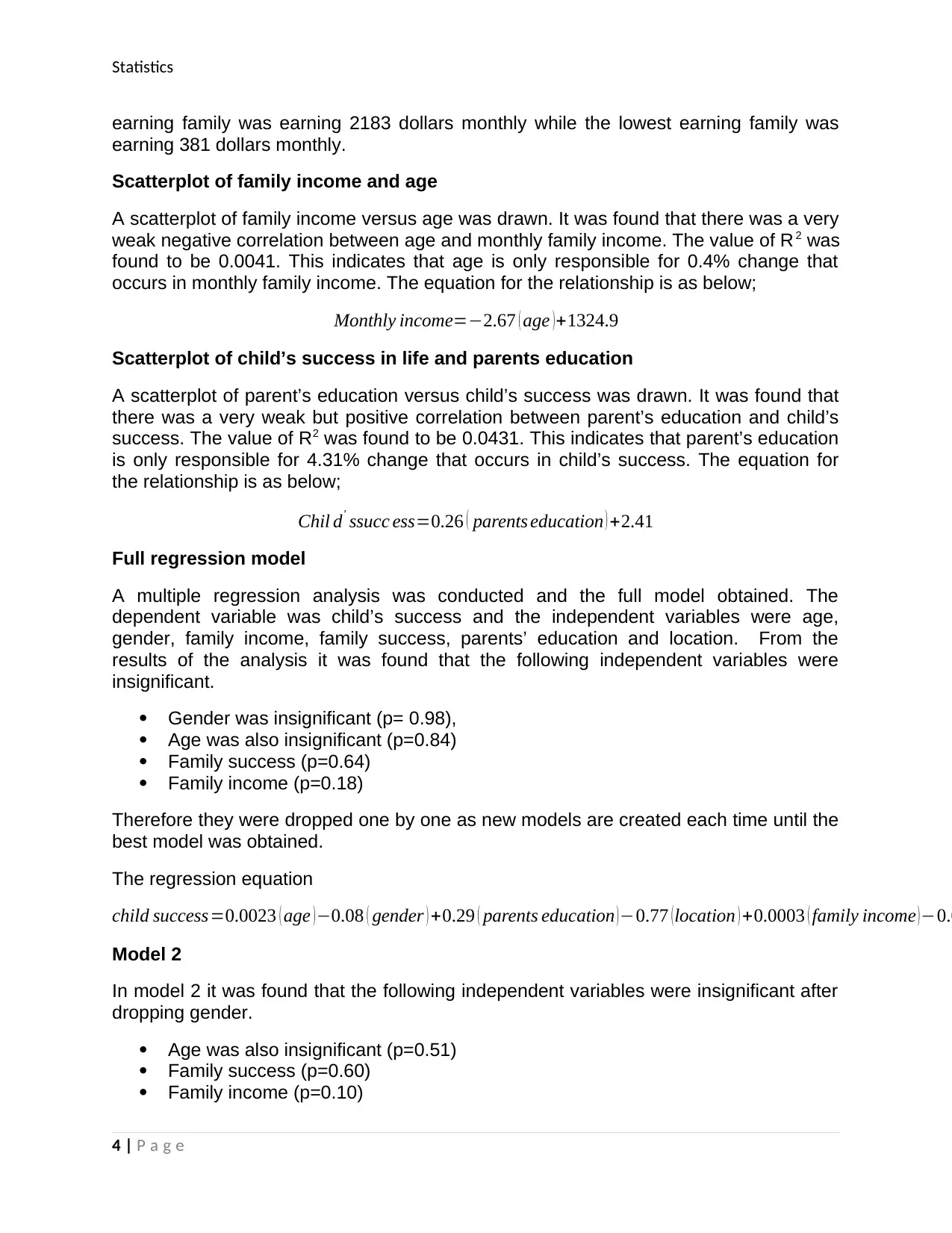
Statistics
earning family was earning 2183 dollars monthly while the lowest earning family was
earning 381 dollars monthly.
Scatterplot of family income and age
A scatterplot of family income versus age was drawn. It was found that there was a very
weak negative correlation between age and monthly family income. The value of R 2 was
found to be 0.0041. This indicates that age is only responsible for 0.4% change that
occurs in monthly family income. The equation for the relationship is as below;
Monthly income=−2.67 ( age )+1324.9
Scatterplot of child’s success in life and parents education
A scatterplot of parent’s education versus child’s success was drawn. It was found that
there was a very weak but positive correlation between parent’s education and child’s
success. The value of R2 was found to be 0.0431. This indicates that parent’s education
is only responsible for 4.31% change that occurs in child’s success. The equation for
the relationship is as below;
Chil d' ssucc ess=0.26 ( parents education ) +2.41
Full regression model
A multiple regression analysis was conducted and the full model obtained. The
dependent variable was child’s success and the independent variables were age,
gender, family income, family success, parents’ education and location. From the
results of the analysis it was found that the following independent variables were
insignificant.
Gender was insignificant (p= 0.98),
Age was also insignificant (p=0.84)
Family success (p=0.64)
Family income (p=0.18)
Therefore they were dropped one by one as new models are created each time until the
best model was obtained.
The regression equation
child success=0.0023 ( age ) −0.08 ( gender ) +0.29 ( parents education ) −0.77 ( location ) +0.0003 ( family income ) −0.0
Model 2
In model 2 it was found that the following independent variables were insignificant after
dropping gender.
Age was also insignificant (p=0.51)
Family success (p=0.60)
Family income (p=0.10)
4 | P a g e
earning family was earning 2183 dollars monthly while the lowest earning family was
earning 381 dollars monthly.
Scatterplot of family income and age
A scatterplot of family income versus age was drawn. It was found that there was a very
weak negative correlation between age and monthly family income. The value of R 2 was
found to be 0.0041. This indicates that age is only responsible for 0.4% change that
occurs in monthly family income. The equation for the relationship is as below;
Monthly income=−2.67 ( age )+1324.9
Scatterplot of child’s success in life and parents education
A scatterplot of parent’s education versus child’s success was drawn. It was found that
there was a very weak but positive correlation between parent’s education and child’s
success. The value of R2 was found to be 0.0431. This indicates that parent’s education
is only responsible for 4.31% change that occurs in child’s success. The equation for
the relationship is as below;
Chil d' ssucc ess=0.26 ( parents education ) +2.41
Full regression model
A multiple regression analysis was conducted and the full model obtained. The
dependent variable was child’s success and the independent variables were age,
gender, family income, family success, parents’ education and location. From the
results of the analysis it was found that the following independent variables were
insignificant.
Gender was insignificant (p= 0.98),
Age was also insignificant (p=0.84)
Family success (p=0.64)
Family income (p=0.18)
Therefore they were dropped one by one as new models are created each time until the
best model was obtained.
The regression equation
child success=0.0023 ( age ) −0.08 ( gender ) +0.29 ( parents education ) −0.77 ( location ) +0.0003 ( family income ) −0.0
Model 2
In model 2 it was found that the following independent variables were insignificant after
dropping gender.
Age was also insignificant (p=0.51)
Family success (p=0.60)
Family income (p=0.10)
4 | P a g e
Secure Best Marks with AI Grader
Need help grading? Try our AI Grader for instant feedback on your assignments.
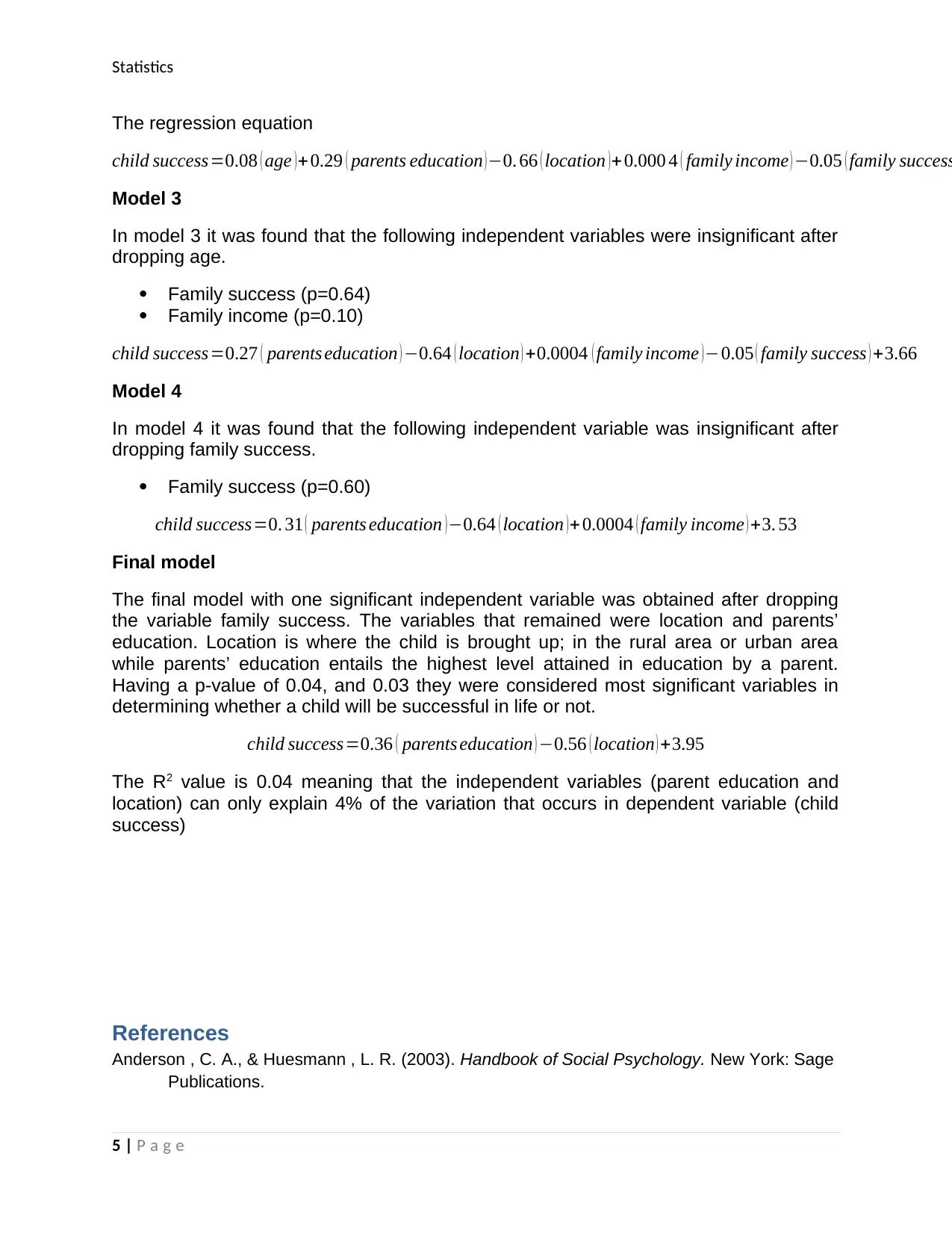
Statistics
The regression equation
child success=0.08 ( age )+0.29 ( parents education )−0. 66 ( location )+0.000 4 ( family income ) −0.05 ( family success
Model 3
In model 3 it was found that the following independent variables were insignificant after
dropping age.
Family success (p=0.64)
Family income (p=0.10)
child success=0.27 ( parents education ) −0.64 ( location ) +0.0004 ( family income ) −0.05 ( family success ) +3.66
Model 4
In model 4 it was found that the following independent variable was insignificant after
dropping family success.
Family success (p=0.60)
child success=0. 31 ( parents education )−0.64 ( location )+0.0004 ( family income ) +3. 53
Final model
The final model with one significant independent variable was obtained after dropping
the variable family success. The variables that remained were location and parents’
education. Location is where the child is brought up; in the rural area or urban area
while parents’ education entails the highest level attained in education by a parent.
Having a p-value of 0.04, and 0.03 they were considered most significant variables in
determining whether a child will be successful in life or not.
child success=0.36 ( parents education ) −0.56 ( location ) +3.95
The R2 value is 0.04 meaning that the independent variables (parent education and
location) can only explain 4% of the variation that occurs in dependent variable (child
success)
References
Anderson , C. A., & Huesmann , L. R. (2003). Handbook of Social Psychology. New York: Sage
Publications.
5 | P a g e
The regression equation
child success=0.08 ( age )+0.29 ( parents education )−0. 66 ( location )+0.000 4 ( family income ) −0.05 ( family success
Model 3
In model 3 it was found that the following independent variables were insignificant after
dropping age.
Family success (p=0.64)
Family income (p=0.10)
child success=0.27 ( parents education ) −0.64 ( location ) +0.0004 ( family income ) −0.05 ( family success ) +3.66
Model 4
In model 4 it was found that the following independent variable was insignificant after
dropping family success.
Family success (p=0.60)
child success=0. 31 ( parents education )−0.64 ( location )+0.0004 ( family income ) +3. 53
Final model
The final model with one significant independent variable was obtained after dropping
the variable family success. The variables that remained were location and parents’
education. Location is where the child is brought up; in the rural area or urban area
while parents’ education entails the highest level attained in education by a parent.
Having a p-value of 0.04, and 0.03 they were considered most significant variables in
determining whether a child will be successful in life or not.
child success=0.36 ( parents education ) −0.56 ( location ) +3.95
The R2 value is 0.04 meaning that the independent variables (parent education and
location) can only explain 4% of the variation that occurs in dependent variable (child
success)
References
Anderson , C. A., & Huesmann , L. R. (2003). Handbook of Social Psychology. New York: Sage
Publications.
5 | P a g e
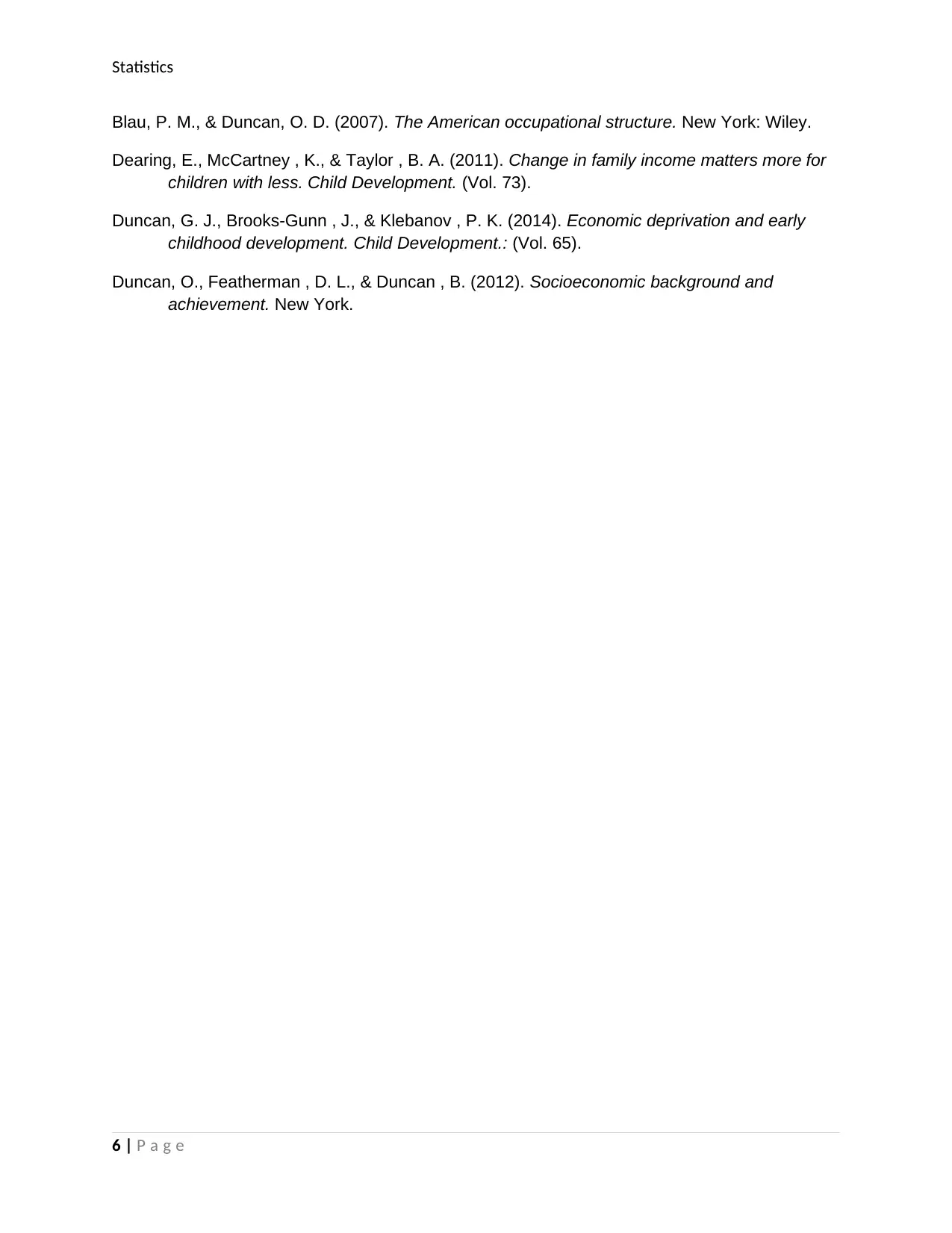
Statistics
Blau, P. M., & Duncan, O. D. (2007). The American occupational structure. New York: Wiley.
Dearing, E., McCartney , K., & Taylor , B. A. (2011). Change in family income matters more for
children with less. Child Development. (Vol. 73).
Duncan, G. J., Brooks-Gunn , J., & Klebanov , P. K. (2014). Economic deprivation and early
childhood development. Child Development.: (Vol. 65).
Duncan, O., Featherman , D. L., & Duncan , B. (2012). Socioeconomic background and
achievement. New York.
6 | P a g e
Blau, P. M., & Duncan, O. D. (2007). The American occupational structure. New York: Wiley.
Dearing, E., McCartney , K., & Taylor , B. A. (2011). Change in family income matters more for
children with less. Child Development. (Vol. 73).
Duncan, G. J., Brooks-Gunn , J., & Klebanov , P. K. (2014). Economic deprivation and early
childhood development. Child Development.: (Vol. 65).
Duncan, O., Featherman , D. L., & Duncan , B. (2012). Socioeconomic background and
achievement. New York.
6 | P a g e
1 out of 6
Related Documents
Your All-in-One AI-Powered Toolkit for Academic Success.
+13062052269
info@desklib.com
Available 24*7 on WhatsApp / Email
![[object Object]](/_next/static/media/star-bottom.7253800d.svg)
Unlock your academic potential
© 2024 | Zucol Services PVT LTD | All rights reserved.
